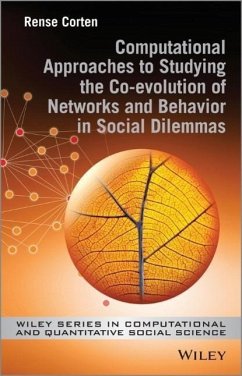Rense Corten
Computational Approaches to Studying the Co-Evolution of Networks and Behavior in Social Dilemmas
Rense Corten
Computational Approaches to Studying the Co-Evolution of Networks and Behavior in Social Dilemmas
- Gebundenes Buch
- Merkliste
- Auf die Merkliste
- Bewerten Bewerten
- Teilen
- Produkt teilen
- Produkterinnerung
- Produkterinnerung
Computational Approaches to Studying the Co-evolution of Networks and Behaviour in Social Dilemmas shows students, researchers, and professionals how to use computation methods, rather than mathematical analysis, to answer research questions for an easier, more productive method of testing their models. Illustrations of general methodology are provided and explore how computer simulation is used to bridge the gap between formal theoretical models and empirical applications.
Andere Kunden interessierten sich auch für
![Analytical Sociology Analytical Sociology]() Analytical Sociology101,99 €
Analytical Sociology101,99 €![Causality in a Social World Causality in a Social World]() Guanglei HongCausality in a Social World91,99 €
Guanglei HongCausality in a Social World91,99 €![The Wellbeing of Nations The Wellbeing of Nations]() Paul AllinThe Wellbeing of Nations73,99 €
Paul AllinThe Wellbeing of Nations73,99 €![Understanding and Applying Research Design Understanding and Applying Research Design]() Martin Lee AbbottUnderstanding and Applying Research Design131,99 €
Martin Lee AbbottUnderstanding and Applying Research Design131,99 €![Agent-Based Computational Sociology Agent-Based Computational Sociology]() Flaminio SquazzoniAgent-Based Computational Sociology81,99 €
Flaminio SquazzoniAgent-Based Computational Sociology81,99 €![Agent-Based Modelling in Economics Agent-Based Modelling in Economics]() Lynne HamillAgent-Based Modelling in Economics67,99 €
Lynne HamillAgent-Based Modelling in Economics67,99 €![Social Networks and Their Economics Social Networks and Their Economics]() Daniel BirkeSocial Networks and Their Economics79,99 €
Daniel BirkeSocial Networks and Their Economics79,99 €-
-
-
Computational Approaches to Studying the Co-evolution of Networks and Behaviour in Social Dilemmas shows students, researchers, and professionals how to use computation methods, rather than mathematical analysis, to answer research questions for an easier, more productive method of testing their models. Illustrations of general methodology are provided and explore how computer simulation is used to bridge the gap between formal theoretical models and empirical applications.
Produktdetails
- Produktdetails
- Wiley Series in Computational and Quantitative Social Science
- Verlag: Wiley & Sons
- 1. Auflage
- Seitenzahl: 192
- Erscheinungstermin: 7. April 2014
- Englisch
- Abmessung: 229mm x 152mm x 18mm
- Gewicht: 386g
- ISBN-13: 9781118636879
- ISBN-10: 1118636872
- Artikelnr.: 40134032
- Herstellerkennzeichnung
- Libri GmbH
- Europaallee 1
- 36244 Bad Hersfeld
- gpsr@libri.de
- Wiley Series in Computational and Quantitative Social Science
- Verlag: Wiley & Sons
- 1. Auflage
- Seitenzahl: 192
- Erscheinungstermin: 7. April 2014
- Englisch
- Abmessung: 229mm x 152mm x 18mm
- Gewicht: 386g
- ISBN-13: 9781118636879
- ISBN-10: 1118636872
- Artikelnr.: 40134032
- Herstellerkennzeichnung
- Libri GmbH
- Europaallee 1
- 36244 Bad Hersfeld
- gpsr@libri.de
Rense Corten Department of Sociology, Utrecht University, The Netherlands benefit from the novel approaches presented in this book.
Preface ix
1 Introduction 1
1.1 Social dilemmas and social networks 1
1.1.1 Cooperation and social networks 4
1.1.2 Coordination and social networks 5
1.2 Dynamic networks, co-evolution, and research questions 6
1.3 Social networks and social dilemmas between sociology and economics 9
1.4 Approach: Models, simulation, and empirical tests 10
1.4.1 Theoretical models 13
1.4.2 Empirical approach 14
1.5 Description of the remaining chapters 15
References 17
2 Consent or conflict: Co-evolution of coordination and networks 23
2.1 Introduction 23
2.1.1 Polarization, conflict, and coordination 24
2.1.2 Coordination and social networks 26
2.2 The model 28
2.3 Stable states 29
2.4 Simulation design 32
2.5 Simulation results 35
2.5.1 Predicting stable states I: Polarization 36
2.5.2 Predicting stable states II: Efficiency 39
2.6 Conclusions and discussion 41
References 42
3 Cooperation and reputation in dynamic networks 47
3.1 Introduction 47
3.1.1 Cooperation and network effects 48
3.1.2 The case for network dynamics 49
3.1.3 Learning in networks 50
3.1.4 Related theoretical literature 51
3.2 The model 52
3.2.1 Formalization of the problem 52
3.2.2 Individual strategies 54
3.2.3 Reputation 56
3.2.4 Network decisions 58
3.2.5 Convergence 59
3.3 Analysis of the model 60
3.3.1 Dynamics of behavior with two actors 60
3.3.2 Stable states in fixed networks 61
3.3.3 Stable states in dynamic networks 63
3.4 Setup of the simulation 65
3.4.1 Dependent variables 66
3.4.2 Parameters of the simulation 66
3.4.3 Initial conditions of the simulation 67
3.4.4 Convergence of the simulation 68
3.5 Simulation results 68
3.5.1 Results for fixed networks 68
3.5.2 Results for dynamic networks 70
3.6 Conclusions and discussion 73
References 77
4 Co-evolution of conventions and networks: An experimental study 81
4.1 Introduction 81
4.1.1 Coordination, conventions, and networks 82
4.1.2 An experimental approach 85
4.2 Model and simulation 86
4.2.1 The model 86
4.2.2 Analytic results 88
4.2.3 Simulation 90
4.2.4 Overview of micro-level and macro-level hypotheses 93
4.3 Experimental design 96
4.4 Results 97
4.4.1 Macro-level results 97
4.4.2 Individual behavior I: Decisions in the coordination game 101
4.4.3 Individual behavior II: Linking decisions 104
4.5 Conclusions and discussion 107
References 109
5 Alcohol use among adolescents as a coordination problem in a dynamic
network 113
5.1 Introduction 113
5.1.1 Coordination, influence, and alcohol use 115
5.1.2 Approaches to the study of selection and influence 117
5.2 Predictions 120
5.3 Data 123
5.3.1 Data collection 123
5.3.2 Variables and measures 123
5.4 Methods of analysis 125
5.5 Results 126
5.5.1 Descriptive results 126
5.5.2 Multilevel regression using combined network measures 130
5.5.3 Multilevel regression using non-reciprocated friendship ties 132
5.5.4 Additional analyses 132
5.6 Conclusions 134
References 136
6 Conclusions 139
6.1 Summary of the findings 139
6.2 Theory, computer simulation, and empirical tests 142
6.3 Suggestions for further research 145
6.3.1 Theoretical extensions 145
6.3.2 Suggestions for empirical studies 148
References 149
Appendix A: Instructions used in the experiment 151
Appendix B: The computer interface used for the experiment 159
Reference 167
Index 169
1 Introduction 1
1.1 Social dilemmas and social networks 1
1.1.1 Cooperation and social networks 4
1.1.2 Coordination and social networks 5
1.2 Dynamic networks, co-evolution, and research questions 6
1.3 Social networks and social dilemmas between sociology and economics 9
1.4 Approach: Models, simulation, and empirical tests 10
1.4.1 Theoretical models 13
1.4.2 Empirical approach 14
1.5 Description of the remaining chapters 15
References 17
2 Consent or conflict: Co-evolution of coordination and networks 23
2.1 Introduction 23
2.1.1 Polarization, conflict, and coordination 24
2.1.2 Coordination and social networks 26
2.2 The model 28
2.3 Stable states 29
2.4 Simulation design 32
2.5 Simulation results 35
2.5.1 Predicting stable states I: Polarization 36
2.5.2 Predicting stable states II: Efficiency 39
2.6 Conclusions and discussion 41
References 42
3 Cooperation and reputation in dynamic networks 47
3.1 Introduction 47
3.1.1 Cooperation and network effects 48
3.1.2 The case for network dynamics 49
3.1.3 Learning in networks 50
3.1.4 Related theoretical literature 51
3.2 The model 52
3.2.1 Formalization of the problem 52
3.2.2 Individual strategies 54
3.2.3 Reputation 56
3.2.4 Network decisions 58
3.2.5 Convergence 59
3.3 Analysis of the model 60
3.3.1 Dynamics of behavior with two actors 60
3.3.2 Stable states in fixed networks 61
3.3.3 Stable states in dynamic networks 63
3.4 Setup of the simulation 65
3.4.1 Dependent variables 66
3.4.2 Parameters of the simulation 66
3.4.3 Initial conditions of the simulation 67
3.4.4 Convergence of the simulation 68
3.5 Simulation results 68
3.5.1 Results for fixed networks 68
3.5.2 Results for dynamic networks 70
3.6 Conclusions and discussion 73
References 77
4 Co-evolution of conventions and networks: An experimental study 81
4.1 Introduction 81
4.1.1 Coordination, conventions, and networks 82
4.1.2 An experimental approach 85
4.2 Model and simulation 86
4.2.1 The model 86
4.2.2 Analytic results 88
4.2.3 Simulation 90
4.2.4 Overview of micro-level and macro-level hypotheses 93
4.3 Experimental design 96
4.4 Results 97
4.4.1 Macro-level results 97
4.4.2 Individual behavior I: Decisions in the coordination game 101
4.4.3 Individual behavior II: Linking decisions 104
4.5 Conclusions and discussion 107
References 109
5 Alcohol use among adolescents as a coordination problem in a dynamic
network 113
5.1 Introduction 113
5.1.1 Coordination, influence, and alcohol use 115
5.1.2 Approaches to the study of selection and influence 117
5.2 Predictions 120
5.3 Data 123
5.3.1 Data collection 123
5.3.2 Variables and measures 123
5.4 Methods of analysis 125
5.5 Results 126
5.5.1 Descriptive results 126
5.5.2 Multilevel regression using combined network measures 130
5.5.3 Multilevel regression using non-reciprocated friendship ties 132
5.5.4 Additional analyses 132
5.6 Conclusions 134
References 136
6 Conclusions 139
6.1 Summary of the findings 139
6.2 Theory, computer simulation, and empirical tests 142
6.3 Suggestions for further research 145
6.3.1 Theoretical extensions 145
6.3.2 Suggestions for empirical studies 148
References 149
Appendix A: Instructions used in the experiment 151
Appendix B: The computer interface used for the experiment 159
Reference 167
Index 169
Preface ix
1 Introduction 1
1.1 Social dilemmas and social networks 1
1.1.1 Cooperation and social networks 4
1.1.2 Coordination and social networks 5
1.2 Dynamic networks, co-evolution, and research questions 6
1.3 Social networks and social dilemmas between sociology and economics 9
1.4 Approach: Models, simulation, and empirical tests 10
1.4.1 Theoretical models 13
1.4.2 Empirical approach 14
1.5 Description of the remaining chapters 15
References 17
2 Consent or conflict: Co-evolution of coordination and networks 23
2.1 Introduction 23
2.1.1 Polarization, conflict, and coordination 24
2.1.2 Coordination and social networks 26
2.2 The model 28
2.3 Stable states 29
2.4 Simulation design 32
2.5 Simulation results 35
2.5.1 Predicting stable states I: Polarization 36
2.5.2 Predicting stable states II: Efficiency 39
2.6 Conclusions and discussion 41
References 42
3 Cooperation and reputation in dynamic networks 47
3.1 Introduction 47
3.1.1 Cooperation and network effects 48
3.1.2 The case for network dynamics 49
3.1.3 Learning in networks 50
3.1.4 Related theoretical literature 51
3.2 The model 52
3.2.1 Formalization of the problem 52
3.2.2 Individual strategies 54
3.2.3 Reputation 56
3.2.4 Network decisions 58
3.2.5 Convergence 59
3.3 Analysis of the model 60
3.3.1 Dynamics of behavior with two actors 60
3.3.2 Stable states in fixed networks 61
3.3.3 Stable states in dynamic networks 63
3.4 Setup of the simulation 65
3.4.1 Dependent variables 66
3.4.2 Parameters of the simulation 66
3.4.3 Initial conditions of the simulation 67
3.4.4 Convergence of the simulation 68
3.5 Simulation results 68
3.5.1 Results for fixed networks 68
3.5.2 Results for dynamic networks 70
3.6 Conclusions and discussion 73
References 77
4 Co-evolution of conventions and networks: An experimental study 81
4.1 Introduction 81
4.1.1 Coordination, conventions, and networks 82
4.1.2 An experimental approach 85
4.2 Model and simulation 86
4.2.1 The model 86
4.2.2 Analytic results 88
4.2.3 Simulation 90
4.2.4 Overview of micro-level and macro-level hypotheses 93
4.3 Experimental design 96
4.4 Results 97
4.4.1 Macro-level results 97
4.4.2 Individual behavior I: Decisions in the coordination game 101
4.4.3 Individual behavior II: Linking decisions 104
4.5 Conclusions and discussion 107
References 109
5 Alcohol use among adolescents as a coordination problem in a dynamic
network 113
5.1 Introduction 113
5.1.1 Coordination, influence, and alcohol use 115
5.1.2 Approaches to the study of selection and influence 117
5.2 Predictions 120
5.3 Data 123
5.3.1 Data collection 123
5.3.2 Variables and measures 123
5.4 Methods of analysis 125
5.5 Results 126
5.5.1 Descriptive results 126
5.5.2 Multilevel regression using combined network measures 130
5.5.3 Multilevel regression using non-reciprocated friendship ties 132
5.5.4 Additional analyses 132
5.6 Conclusions 134
References 136
6 Conclusions 139
6.1 Summary of the findings 139
6.2 Theory, computer simulation, and empirical tests 142
6.3 Suggestions for further research 145
6.3.1 Theoretical extensions 145
6.3.2 Suggestions for empirical studies 148
References 149
Appendix A: Instructions used in the experiment 151
Appendix B: The computer interface used for the experiment 159
Reference 167
Index 169
1 Introduction 1
1.1 Social dilemmas and social networks 1
1.1.1 Cooperation and social networks 4
1.1.2 Coordination and social networks 5
1.2 Dynamic networks, co-evolution, and research questions 6
1.3 Social networks and social dilemmas between sociology and economics 9
1.4 Approach: Models, simulation, and empirical tests 10
1.4.1 Theoretical models 13
1.4.2 Empirical approach 14
1.5 Description of the remaining chapters 15
References 17
2 Consent or conflict: Co-evolution of coordination and networks 23
2.1 Introduction 23
2.1.1 Polarization, conflict, and coordination 24
2.1.2 Coordination and social networks 26
2.2 The model 28
2.3 Stable states 29
2.4 Simulation design 32
2.5 Simulation results 35
2.5.1 Predicting stable states I: Polarization 36
2.5.2 Predicting stable states II: Efficiency 39
2.6 Conclusions and discussion 41
References 42
3 Cooperation and reputation in dynamic networks 47
3.1 Introduction 47
3.1.1 Cooperation and network effects 48
3.1.2 The case for network dynamics 49
3.1.3 Learning in networks 50
3.1.4 Related theoretical literature 51
3.2 The model 52
3.2.1 Formalization of the problem 52
3.2.2 Individual strategies 54
3.2.3 Reputation 56
3.2.4 Network decisions 58
3.2.5 Convergence 59
3.3 Analysis of the model 60
3.3.1 Dynamics of behavior with two actors 60
3.3.2 Stable states in fixed networks 61
3.3.3 Stable states in dynamic networks 63
3.4 Setup of the simulation 65
3.4.1 Dependent variables 66
3.4.2 Parameters of the simulation 66
3.4.3 Initial conditions of the simulation 67
3.4.4 Convergence of the simulation 68
3.5 Simulation results 68
3.5.1 Results for fixed networks 68
3.5.2 Results for dynamic networks 70
3.6 Conclusions and discussion 73
References 77
4 Co-evolution of conventions and networks: An experimental study 81
4.1 Introduction 81
4.1.1 Coordination, conventions, and networks 82
4.1.2 An experimental approach 85
4.2 Model and simulation 86
4.2.1 The model 86
4.2.2 Analytic results 88
4.2.3 Simulation 90
4.2.4 Overview of micro-level and macro-level hypotheses 93
4.3 Experimental design 96
4.4 Results 97
4.4.1 Macro-level results 97
4.4.2 Individual behavior I: Decisions in the coordination game 101
4.4.3 Individual behavior II: Linking decisions 104
4.5 Conclusions and discussion 107
References 109
5 Alcohol use among adolescents as a coordination problem in a dynamic
network 113
5.1 Introduction 113
5.1.1 Coordination, influence, and alcohol use 115
5.1.2 Approaches to the study of selection and influence 117
5.2 Predictions 120
5.3 Data 123
5.3.1 Data collection 123
5.3.2 Variables and measures 123
5.4 Methods of analysis 125
5.5 Results 126
5.5.1 Descriptive results 126
5.5.2 Multilevel regression using combined network measures 130
5.5.3 Multilevel regression using non-reciprocated friendship ties 132
5.5.4 Additional analyses 132
5.6 Conclusions 134
References 136
6 Conclusions 139
6.1 Summary of the findings 139
6.2 Theory, computer simulation, and empirical tests 142
6.3 Suggestions for further research 145
6.3.1 Theoretical extensions 145
6.3.2 Suggestions for empirical studies 148
References 149
Appendix A: Instructions used in the experiment 151
Appendix B: The computer interface used for the experiment 159
Reference 167
Index 169








